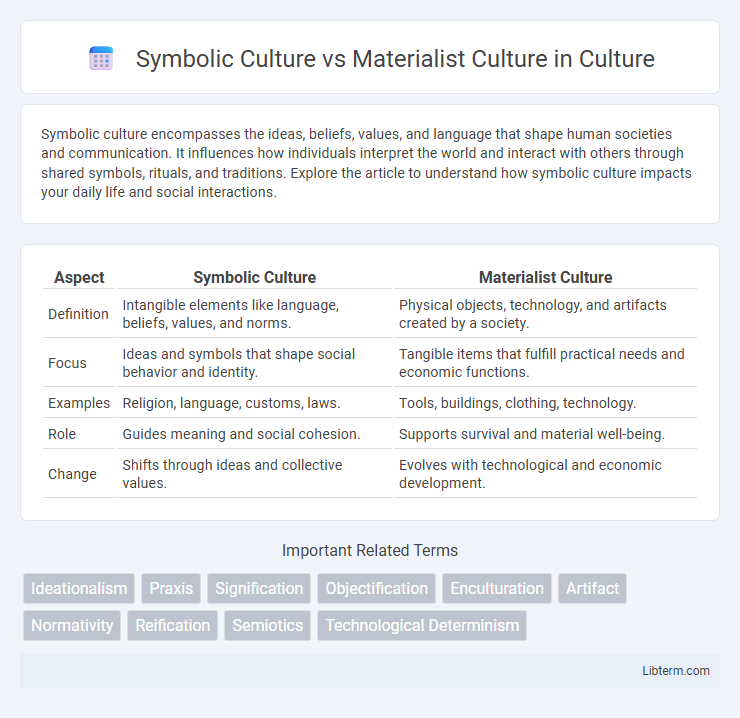Symbolic culture encompasses the ideas, beliefs, values, and language that shape human societies and communication. It influences how individuals interpret the world and interact with others through shared symbols, rituals, and traditions. Explore the article to understand how symbolic culture impacts your daily life and social interactions.
Table of Comparison
| Aspect | Symbolic Culture | Materialist Culture |
|---|---|---|
| Definition | Intangible elements like language, beliefs, values, and norms. | Physical objects, technology, and artifacts created by a society. |
| Focus | Ideas and symbols that shape social behavior and identity. | Tangible items that fulfill practical needs and economic functions. |
| Examples | Religion, language, customs, laws. | Tools, buildings, clothing, technology. |
| Role | Guides meaning and social cohesion. | Supports survival and material well-being. |
| Change | Shifts through ideas and collective values. | Evolves with technological and economic development. |
Defining Symbolic Culture
Symbolic culture refers to the system of shared symbols, language, values, beliefs, and norms that shape human behavior and social practices, emphasizing intangible aspects such as meanings and ideas. It contrasts with materialist culture, which centers on physical objects, technology, and economic conditions that influence societal development. Defining symbolic culture involves understanding how symbols and meanings create social reality and guide interactions within a community.
Understanding Materialist Culture
Materialist culture emphasizes the tangible, physical aspects of society such as technology, economic systems, and infrastructure that shape human behavior and social organization. Understanding materialist culture involves analyzing how material conditions and resources influence cultural practices, social relations, and historical development. This perspective reveals the direct impact of economic production and material wealth on societal values and power structures.
Key Differences Between Symbolic and Materialist Culture
Symbolic culture centers on intangible elements such as language, beliefs, values, and symbols that shape social identity and communication, whereas materialist culture emphasizes physical objects, technology, and economic means that influence daily life and societal development. Key differences include the role of symbols versus artifacts, with symbolic culture relying on shared meanings and materialist culture prioritizing tangible resources and production. Understanding these distinctions highlights how societies construct reality through both mental frameworks and material conditions.
Origins and Historical Context
Symbolic culture, rooted in the use of language, art, religion, and rituals, emerges from early human cognitive development and social organization, tracing back to prehistoric times when symbolic communication enhanced group cohesion. Materialist culture originates from the tangible, economic, and technological aspects of human life, reflecting historical shifts such as the Agricultural and Industrial Revolutions that transformed production and societal structures. These cultural dimensions evolved in tandem but emphasize different foundations: symbolic culture highlights meaning-making and shared beliefs, while materialist culture focuses on physical resources and economic interactions shaping human societies.
Examples of Symbolic Culture in Society
Symbolic culture encompasses non-material elements such as language, beliefs, values, norms, and symbols that shape societal interactions and convey meaning beyond physical objects. Examples of symbolic culture include national flags representing patriotism, religious rituals expressing faith, and language serving as a medium for communication and cultural identity. These symbols guide behavior and foster social cohesion by transmitting shared meanings within communities.
Manifestations of Materialist Culture
Manifestations of materialist culture primarily include tangible artifacts, technology, infrastructure, and economic systems that shape human behavior and societal development. These physical elements reflect the material conditions and resources available, driving social organization, production methods, and daily practices. Materialist culture emphasizes practical, economic, and utilitarian aspects, influencing how societies evolve and sustain themselves through concrete, observable means.
Influence on Social Identity and Behavior
Symbolic culture, encompassing language, beliefs, and values, shapes social identity by providing shared meanings that guide individual behavior and group cohesion. Materialist culture, focusing on physical objects and economic practices, influences social identity through access to resources and social status, affecting behavior patterns linked to consumption and production. The interplay between symbolic and materialist culture creates complex social dynamics that define individual roles and collective interactions within society.
Symbolic vs Materialist Culture in Modern Life
Symbolic culture shapes modern life through language, art, and rituals that construct shared meanings and social identities, influencing behaviors beyond tangible objects. Materialist culture prioritizes physical resources, technology, and economic factors, driving innovation, consumption patterns, and urban development in contemporary societies. The interaction between symbolic and materialist culture underpins social dynamics, as symbolic meanings often guide material practices and vice versa in everyday life.
The Role of Technology and Media
Symbolic culture relies on shared meanings, symbols, and language to shape social reality, while materialist culture emphasizes tangible objects, technology, and economic factors in societal development. Technology and media serve as crucial mediators in both, driving the creation and dissemination of symbolic meanings and material innovations that influence cultural norms and behaviors. The rapid evolution of digital media platforms accelerates the interaction between symbolic representations and material resources, transforming communication, identity construction, and power dynamics in contemporary societies.
Balancing Symbolic and Materialist Perspectives
Balancing symbolic and materialist perspectives involves integrating the significance of cultural meanings, symbols, and rituals with tangible economic and social conditions shaping human behavior. Recognizing symbolic culture highlights how shared values and ideologies influence identity and social cohesion, while materialist culture emphasizes resource distribution and production modes driving societal change. Effective analysis requires synthesizing both viewpoints to understand complex cultural dynamics and their impact on individual and collective experiences.
Symbolic Culture Infographic

 libterm.com
libterm.com